The month of August has seen a lot of discussion on Helicopter Money. While on one hand, China declares that Helicopter ماكينة عد النقود وكشف التزوير could bring in the hyperinflation, the US have already gone ahead with this tool for fighting deflation. On the other hand, Japan has to disappoint the market by saying no to the Helicopter Money.
It is precisely this in the theory given by Milton Friedman that says to assume that one day a helicopter flies over a community and drops some additional amount of money in bills from the sky. These bills are hastily collected by the community members, and this entire event is a one-time occurrence. According to his theory, the excited members would rush to spend. Higher money supply with no change in output would lift the inflation. It is more like a steroid shot for the economies for keeping them going.
The term is an old gift of economists which has re-emerged in new packaging. In the terms of Banks and Analysts, Helicopter money is the Central Bank injecting cash directly into the economy by buying Government bonds. The term has been introduced as an alternative to Quantitative Easing when there are negative interest rates.
The term is used to refer to a wide range of policies including permanent monetization of the budget deficit, which, in old term, was called debt-monetization. But, it has an additional element of attempting to shock the beliefs about future inflation.
Another tool, which is all the more closer to the original description of the term and is more innovative, is Central Bank making direct transfers to the private sector by buying the corporate bonds.
Critics have a variety of objections to the theory of Helicopter Money and its implementation. For some critics, Helicopter money is a free lunch or free money in the simplest sense that if the phenomenon works and succeeds in closing the gap, people will not have to repay it through undesired inflation and higher taxes. The idea has been dismissed by many for the reason that it may cause hyper-inflation because it will undermine the trust in the currency.
Otmar Issing, a German Economist, said that the whole concept is devastating for it is no better than declaring bankruptcy of the monetary policy. Richard Koo also voiced the similar concern stating that if such bills arrive day after day to the public, the entire country would soon lose all sense of their currency’s worth. And this may lead to a panic among the countrymen.
Various economies are reacting differently to the theory of Helicopter Money. Analysts say that the phenomenon is more like leading the horse to the water and making it drink. In India, Raghuram Rajan, the Central Banker, along with many economists, is opposed to the theory on the other grounds. They claim that, in the country like India, people would not spend the money due to many reasons. Hence, anything that has to do with infusing free money for their spending will not work. Moreover, the government and RBI are keeping a hawk-like watch on the inflation and deficits in the economy. Hence, the country is not going to see the ‘free money’ anytime soon.
China, on the other hand, is not ready to apply the theory for it firmly believes that infusing such kind of money will lead to hyper-inflation and would lead to the undermining of the currency. Also, if a developing economy starts printing money, it could mean the end of entire market.
Japan is dead-set against applying the Helicopter Money for the different reason. The tool, for the country, is like a cat chasing its own tail, due to the demography. The country is Buying Exchange Traded Funds to fight the deflation and in the desire to support its market. But, Japan’s attempt of supporting the market could be dangerous for it is more like interfering in the market.
But the US has topped the chart by making its horse drink the water. The Federal Bank has bought the bonds from the Government and from corporations for infusing the liquidity in the economy. The bank raised the interest rates gradually and sold the bonds as the economy settled itself on the better side. The process began in 2002 and was closed by 2013.
